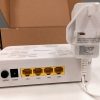Openreach UK Trial G.INP Tweak to Raise FTTC Broadband Stability
Openreach (BT) has announced plans to trial higher levels of ReTransmission (ReTx / G.INP) technology on their Fibre-to-the-Cabinet (FTTC) based “superfast broadband” capable ISP lines, which they believe could slightly improve service speed and help stability.
G.INP (ITU G.998.4) is an error correction solution that is designed to help resolve spikes of Electromagnetic Interference (impulse noise), which can impact the stability and performance of hybrid fibre VDSL2 / FTTC lines. The introduction of this technology can, on some lines, even produce a small increase in service speed.
Openreach has in fact been using G.INP (ITU G.998.4) technology within their hybrid fibre network for awhile, although historically it’s tended to work much better on their Huawei based estate than those of their ECI cabinets (last we saw in 2018 they had got it operating on quite a lot of ECI lines – here – but not all and since then.. silence).
Advertisement
Unfortunately there’s no detail about the new trial on Openreach’s public briefing (here) and so we’ve had to do a little sleuthing. As we understand it the opt-in ISP trial, which we believe is set to begin around mid-July 2019 and run for 8 weeks, will test higher levels of ReTx in both downstream and upstream directions (the goal being a reduced fault rate / more stability).
The trial is expected to involve around 160,000 lines, split between the ISPs that opt-in. Interestingly the main approach they will take to increasing the amount of ReTx in the network is by setting this to always-on in the upstream (upstream ReTx has in the past been quite challenging to get working across their whole network but they have since solved some of those issues).
Mark is a professional technology writer, IT consultant and computer engineer from Dorset (England), he also founded ISPreview in 1999 and enjoys analysing the latest telecoms and broadband developments. Find me on X (Twitter), Mastodon, Facebook, BlueSky, Threads.net and Linkedin.
« Poor UK Mobile Signals Cause 21% of Brits to Stop Gym Exercises

















































Comments are closed